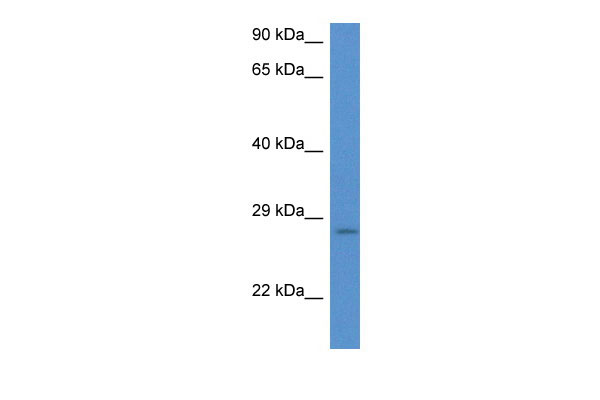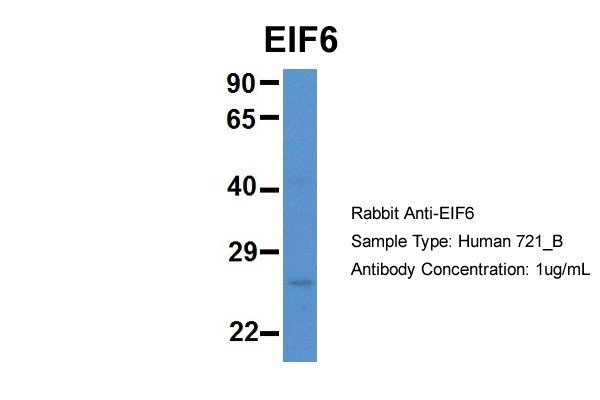EIF6 antibody - N-terminal region
Rabbit Polyclonal Antibody
- SPECIFICATION
- CITATIONS
- PROTOCOLS
- BACKGROUND

Application
| WB |
|---|---|
| Primary Accession | P56537 |
| Other Accession | NM_002212, NP_002203 |
| Reactivity | Human, Mouse, Rat, Rabbit, Sheep, Horse, Yeast, Bovine, Guinea Pig, Dog |
| Predicted | Human, Mouse, Chicken, Sheep, Guinea Pig, Dog |
| Host | Rabbit |
| Clonality | Polyclonal |
| Calculated MW | 27kDa |
| Gene ID | 3692 |
|---|---|
| Alias Symbol | 2, CAB, EIF3A, ITGB4BP, b, b(2)gcn, gcn, p27BBP, eIF-6, p27(BBP) |
| Other Names | Eukaryotic translation initiation factor 6 {ECO:0000255|HAMAP-Rule:MF_03132}, eIF-6 {ECO:0000255|HAMAP-Rule:MF_03132}, B(2)GCN homolog, B4 integrin interactor, CAB, p27(BBP), EIF6 {ECO:0000255|HAMAP-Rule:MF_03132} |
| Format | Liquid. Purified antibody supplied in 1x PBS buffer with 0.09% (w/v) sodium azide and 2% sucrose. |
| Reconstitution & Storage | Add 50 ul of distilled water. Final anti-EIF6 antibody concentration is 1 mg/ml in PBS buffer with 2% sucrose. For longer periods of storage, store at 20°C. Avoid repeat freeze-thaw cycles. |
| Precautions | EIF6 antibody - N-terminal region is for research use only and not for use in diagnostic or therapeutic procedures. |
| Name | EIF6 {ECO:0000255|HAMAP-Rule:MF_03132, ECO:0000312|HGNC:HGNC:6159} |
|---|---|
| Function | Binds to the 60S ribosomal subunit and prevents its association with the 40S ribosomal subunit to form the 80S initiation complex in the cytoplasm (PubMed:10085284, PubMed:14654845, PubMed:21536732, PubMed:32669547). Behaves as a stimulatory translation initiation factor downstream insulin/growth factors. Is also involved in ribosome biogenesis. Associates with pre-60S subunits in the nucleus and is involved in its nuclear export. Cytoplasmic release of TIF6 from 60S subunits and nuclear relocalization is promoted by a RACK1 (RACK1)- dependent protein kinase C activity (PubMed:10085284, PubMed:14654845, PubMed:21536732). In tissues responsive to insulin, controls fatty acid synthesis and glycolysis by exerting translational control of adipogenic transcription factors such as CEBPB, CEBPD and ATF4 that have G/C rich or uORF in their 5'UTR. Required for ROS-dependent megakaryocyte maturation and platelets formation, controls the expression of mitochondrial respiratory chain genes involved in reactive oxygen species (ROS) synthesis (By similarity). Involved in miRNA-mediated gene silencing by the RNA-induced silencing complex (RISC). Required for both miRNA-mediated translational repression and miRNA-mediated cleavage of complementary mRNAs by RISC (PubMed:17507929). Modulates cell cycle progression and global translation of pre-B cells, its activation seems to be rate-limiting in tumorigenesis and tumor growth (By similarity). |
| Cellular Location | Cytoplasm. Nucleus, nucleolus. Note=Shuttles between cytoplasm and nucleus/nucleolus |
| Tissue Location | Expressed at very high levels in colon carcinoma with lower levels in normal colon and ileum and lowest levels in kidney and muscle (at protein level). |

Thousands of laboratories across the world have published research that depended on the performance of antibodies from Abcepta to advance their research. Check out links to articles that cite our products in major peer-reviewed journals, organized by research category.
info@abcepta.com, and receive a free "I Love Antibodies" mug.
Provided below are standard protocols that you may find useful for product applications.
References
Si K.,et al.Proc. Natl. Acad. Sci. U.S.A. 94:14285-14290(1997).
Biffo S.,et al.J. Biol. Chem. 272:30314-30321(1997).
Donadini A.,et al.Gene 266:35-43(2001).
Mao M.,et al.Proc. Natl. Acad. Sci. U.S.A. 95:8175-8180(1998).
Ota T.,et al.Nat. Genet. 36:40-45(2004).
If you have used an Abcepta product and would like to share how it has performed, please click on the "Submit Review" button and provide the requested information. Our staff will examine and post your review and contact you if needed.
If you have any additional inquiries please email technical services at tech@abcepta.com.













 Foundational characteristics of cancer include proliferation, angiogenesis, migration, evasion of apoptosis, and cellular immortality. Find key markers for these cellular processes and antibodies to detect them.
Foundational characteristics of cancer include proliferation, angiogenesis, migration, evasion of apoptosis, and cellular immortality. Find key markers for these cellular processes and antibodies to detect them. The SUMOplot™ Analysis Program predicts and scores sumoylation sites in your protein. SUMOylation is a post-translational modification involved in various cellular processes, such as nuclear-cytosolic transport, transcriptional regulation, apoptosis, protein stability, response to stress, and progression through the cell cycle.
The SUMOplot™ Analysis Program predicts and scores sumoylation sites in your protein. SUMOylation is a post-translational modification involved in various cellular processes, such as nuclear-cytosolic transport, transcriptional regulation, apoptosis, protein stability, response to stress, and progression through the cell cycle. The Autophagy Receptor Motif Plotter predicts and scores autophagy receptor binding sites in your protein. Identifying proteins connected to this pathway is critical to understanding the role of autophagy in physiological as well as pathological processes such as development, differentiation, neurodegenerative diseases, stress, infection, and cancer.
The Autophagy Receptor Motif Plotter predicts and scores autophagy receptor binding sites in your protein. Identifying proteins connected to this pathway is critical to understanding the role of autophagy in physiological as well as pathological processes such as development, differentiation, neurodegenerative diseases, stress, infection, and cancer.



